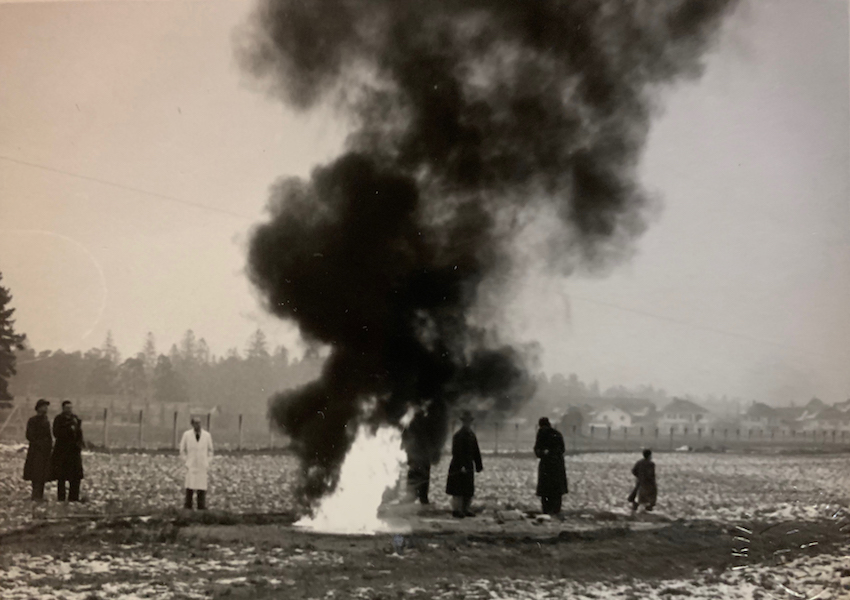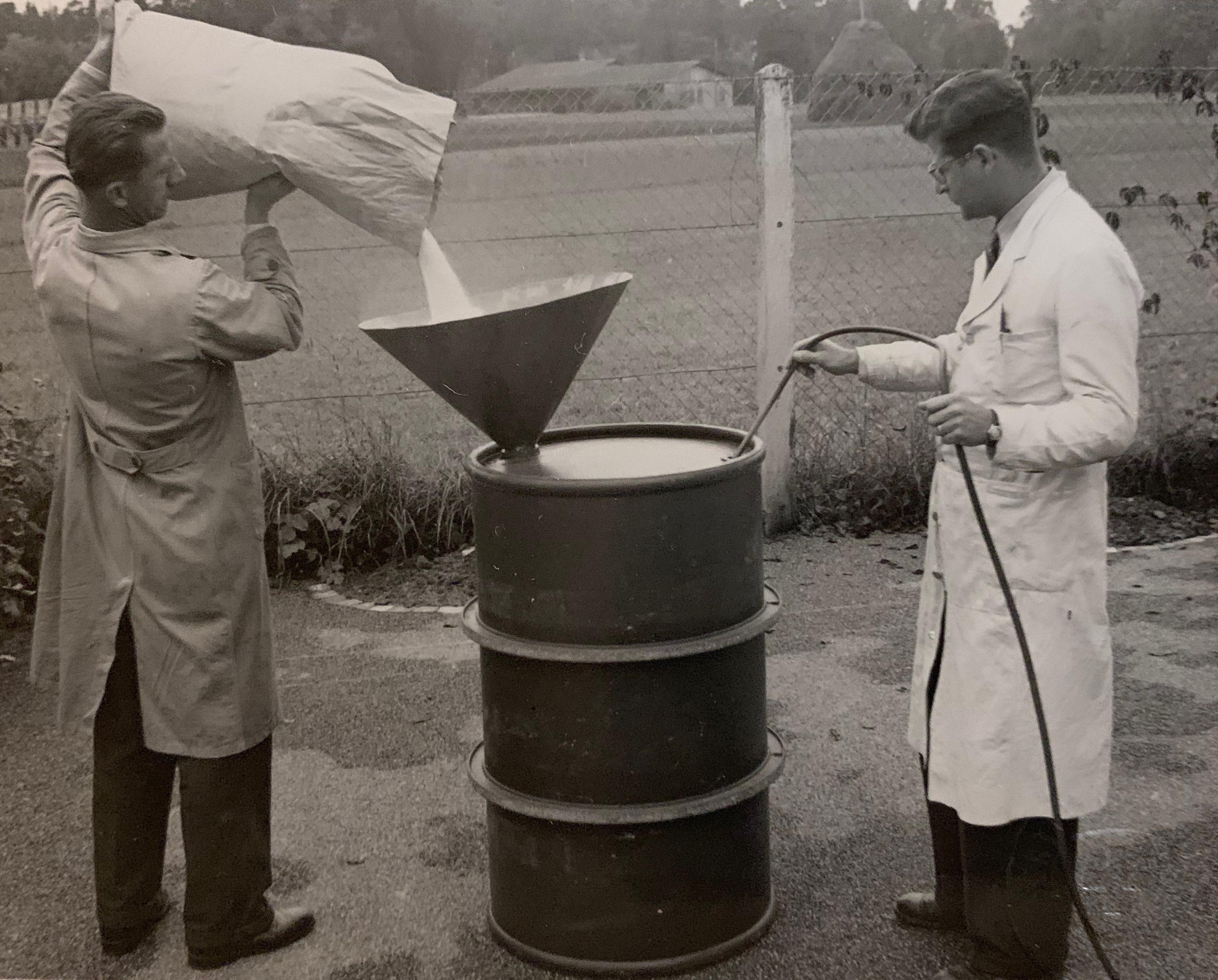
Napalm from the Alps: How the Swiss developed a lethal incendiary agent

For years the napalm variant Opalm was delivered to warring countries around the world. The deadly incendiary weapon was long thought to be a Soviet product, but now we know it was developed in Switzerland.
At the end of the 1970s the Indonesian Air Force made a propaganda film which showed soldiers attaching bombs to the wings of an American OV-10F Bronco fighter jet. The bombs bore the logo “BOM-OPALM” and were intended to be dropped on East Timor, which had been fighting for independence since 1975.
The incendiary agent Opalm was considered the Soviet version of the American napalm, but recently discovered documents show that it was actually a Swiss product. It was developed in Domat/Ems in eastern Switzerland, tested by the Swiss Air Force and produced in Germany on behalf of a Swiss company.

The story begins in the early 1950s when the US Air Force dropped 32,000 tonnes of napalm on the Korean peninsula. Military experts were excited because napalm could cause a lot of destruction for little money. The Swiss press reported how “a napalm bomb covers almost 2,000 square metres with its scorching flames and destroys every living being within range”.
The Swiss army also wanted to get its hands on the new weapon. It was spoilt for choice: in 1950 a US company sent a napalm sample to Switzerland, while a little later the French offered “Octogel” and the Dutch “Metavon”. In 1952 another deadly agent surfaced: the Swiss company Holzverzuckerungs AG (HOVAG) was offering an “improved napalm” called Opalm.
Opalm was the brainchild of Werner Oswald, the founder of HOVAG. He had run a government-subsidised plant producing substitute fuel in Domat/Ems since 1941. But when petrol imports resumed after the end of the Second World War, his fuel was no longer in demand. He needed new business ideas, and napalm, a mixture of gasoline and thickening agents, was one of them.
Oswald developed Opalm and patented it. When he offered to sell it to the Swiss army, he argued that in the event of war HOVAG could guarantee production independent of foreign countries. Although the government, which was in charge of the purchase, was convinced that Opalm was “at least as good as” foreign products, it decided against buying it as it was four times as expensive as napalm from the US.
Circumventing the law
This did not faze Oswald as he had already found another customer abroad. The government of Burma, a country plagued by internal conflicts since its independence in 1948, ordered Opalm for thousands of bombs including shells and detonators which were to be produced by HOVAG’s Swiss partner companies. When the Swiss government in 1954 refused to issue an export licence, Oswald simply moved production to Germany.

In the mid-Fifties there was no law in Germany regulating the export of incendiary agents, so the production plant was dismantled in Domat/Ems and rebuilt in the German city of Karlsruhe. The Swiss chemist who had developed Opalm travelled specifically to Karlsruhe to show Oswald’s new business partner, the German arms dealer Walter Heck, how to make the “secret recipe”.
It was a classic workaround: sales were conducted in Switzerland, while the incendiary agent was produced in Germany from where it was delivered to buyers. Even though it wasn’t in line with the spirit of the Swiss arms law, such a procedure was made legal in 1951 provided the finished weapons never touched Swiss soil.
At the same time, Oswald transferred all business dealings with Opalm to PATVAG, a company he owned with his brothers. This meant the profits didn’t end up with government-subsidised HOVAG, which had financed the development of Opalm, but went straight into the pockets of the Oswald family.
Having recently rejected the export of Opalm, the Swiss government now approved the delivery to Burma of thousands of bombshells produced in Basel. As for the detonators, PATVAG director Erwin Widmer did what many arms dealers were doing: he declared them to be “plastic containers” when he wanted to send them to Pakistan, where one of his employees was preparing an Opalm presentation for the army.
The scam was uncovered by a suspicious Swiss customs official, but Widmer used his good connections to the government and applied for a second – correct – export licence, which he was immediately granted. However, when an outraged HOVAG employee told a newspaper editor about the “plastic containers” and false declarations, the authorities kept quiet and referred to professional secrecy. The PATVAG director received only a tiny fine for the falsely declared detonators.
While the scientists in Domat/Ems continued to improve Opalm and find additives that would make the burning effect even more devastating, HOVAG was looking for new customers. In the summer of 1955 the company sent samples to NATO and several European and Arab countries. Jordan, Syria and Egypt purchased an undisclosed amount of Opalm. The Egyptian Air Force used it to bomb defenceless civilians during the Yemeni Civil War between 1962 and 1967. Police files and letters connected to PATVAG even indicate that the company had sold a licence to the Egyptian army and was involved in the construction of an Opalm production plant near Cairo.
The Algerian National Liberation Front (FLN) was another customer. PATVAG’S German business partner Walter Heck supplied it with Opalm and flamethrowers which he declared to be “pest control devices”. In 1961 Heck was shot dead in the street, as were several German and Swiss arms dealers before and after him who had supplied the FLN. The French secret service was almost certainly behind the assassinations, as they were doing everything they could to prevent the insurgents of Algeria, which was a French colony, from obtaining arms.
Opalm in Indonesia
In the case of Indonesia, HOVAG again applied for a Swiss export licence in 1957 – and the Swiss government again refused to issue it. This is why the orders were probably processed through Germany, but there is no evidence for this. What is on record is the fact that in 1960 an Indonesian delegation visited the production plant in Karlsruhe and ordered 15 tonnes of Opalm including bombshells.
This was not the last order. A letter from PATVAG confirms that the company made “repeated” deliveries to Indonesia. There is proof that Indonesia ordered enough material for around 3,500 bombs, but it is not known what these deliveries were used for.
The Commission for Reception, Truth and Reconciliation in East Timor (CAVR), which documented war atrocities during the 24 years of Indonesia’s occupation of East Timor, discovered not only the propaganda film mentioned at the beginning of this article but also a document in which the Indonesian Army listed the characteristics of Opalm: “Burns targets with a heat of +/– 1,725°C for 15 minutes in a radius of 600m” was one of them. An eyewitness reported: “The bombs simply incinerated people and turned them to ash.”
When CAVR published its final report in 2006, the Indonesian defence minister denied napalm had been used in East Timor. “Back then we didn’t have the capacity to import napalm, let alone produce it,” he said.
However, documents found in German and Swiss archives about the Opalm dealings with Indonesia contradict this claim. Either way, it is a fact that Indonesia has still not signed the Protocol on Prohibitions or Restrictions on the use of Incendiary Weapons which came into force in 1983.
Regula Bochsler: ‘Nylon and Napalm. The story of the Emser Werke and its founder Werner Oswald’. Published by Hier & Jetzt, 2022External link.
Translated from German by Billi Bierling/ts

In compliance with the JTI standards
More: SWI swissinfo.ch certified by the Journalism Trust Initiative


















![The four-metre-long painting "Sonntag der Bergbauern" [Sunday of the Mountain Farmers, 1923-24/26] had to be removed by a crane from the German Chancellery in Berlin for the exhibition in Bern.](https://www.swissinfo.ch/content/wp-content/uploads/sites/13/2025/12/01_Pressebild_KirchnerxKirchner.jpg?ver=1ea8acae)










You can find an overview of ongoing debates with our journalists here . Please join us!
If you want to start a conversation about a topic raised in this article or want to report factual errors, email us at english@swissinfo.ch.